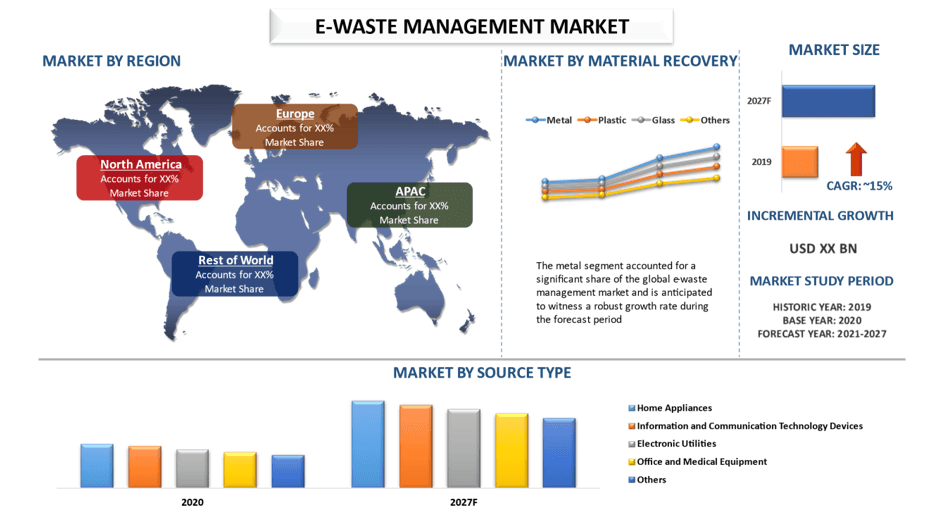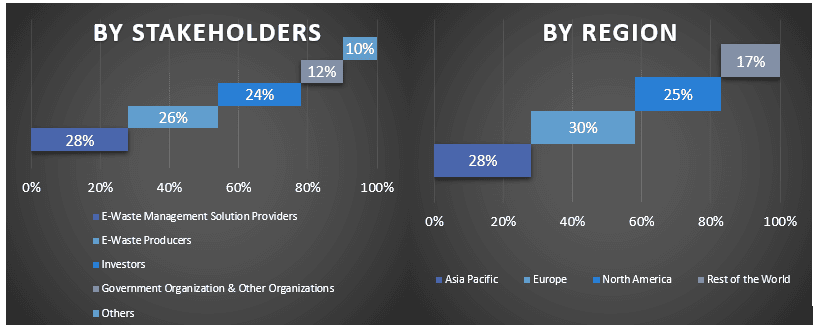
預計2021-2027年全球電子垃圾管理市場的複合年增長率約為15%。由於電子產品的快速淘汰以及可支配收入的增加,全球電子垃圾管理市場正在提升。此外,對稀有金屬的需求不斷增長,以及電子產品的壽命縮短,將積極刺激產業發展。電子垃圾必須進行收集、回收和再利用,因為它對環境有害,大多數電子設備和硬體都含有某些形式的有毒物質,包括鈹、鎘、汞、鉛等,這些物質對土壤、水、空氣和野生動物構成嚴重的環境風險。此外,根據世界衛生組織(WHO)的說法,直接接觸從電子垃圾中滲出的有毒化合物可能會導致健康風險。危險可能來自吸入有毒煙霧,以及化學物質在土壤和水中積累。對電子垃圾管理效益的認識提高以及對環境問題日益關注,將推動對電子垃圾管理的需求。
Boliden AB、MBA Polymers Inc.、Electronic Recyclers International Inc.、Aurubis AG、Sims Metal Management Ltd.、Umicore S.A.、Stena Technoworld AB、Enviro-Hub Holdings Ltd.、Global Electric Electronic Processing Inc.、Tetronics Environmental Waste Treatment Company是市場上的一些主要參與者。這些公司進行了幾項併購以及合作夥伴關係,以便為客戶提供高科技和創新產品/技術。
報告中提供的見解
“在材料回收中,金屬類別在2020年佔據了市場的主要份額”
根據材料回收,市場分為金屬、塑料、玻璃和其他。2020年,金屬部門在全球電子垃圾管理市場中佔據了重要份額,預計在預測期內將呈現強勁的增長率。該部門增長的最主要原因之一是,從電子垃圾中回收金屬可顯著降低對金、銀、銅等貴重金屬的開採、加工和提取的依賴性。
“在來源類型中,家用電器類別在2020年佔據了市場的主要份額”
根據來源類型,市場分為家用電器、資訊和通信技術設備、電子公用設施、辦公和醫療設備等。其中,家用電器在2020年佔據了全球電子垃圾管理市場的主要份額,預計在預測期內將以穩定的速度增長。推動該部門增長的一些最主要因素是可支配收入的增加以及智慧設備和物聯網設備在家庭中的採用率不斷提高。
“預計北美在預測期內將實現顯著增長”
北美在2020年佔據了全球電子垃圾管理市場的主要份額,預計在預測期內將呈現可觀的增長率。這可歸因於對數位轉型的強烈重視以及成為下一代技術採用者的趨勢。北美洲的許多企業和家庭正在開發智慧基礎設施,以實現便利和舒適。此外,為了實現淨零排放目標,電子垃圾管理已成為該地區大多數國家減少碳排放的核心策略之一,因為電子垃圾顯著加劇了整體污染。
購買本報告的理由:
- 該研究包括由經過驗證的主要行業專家驗證的市場規模和預測分析。
- 該報告以簡潔的方式快速回顧了整體行業績效。
- 該報告涵蓋了對主要行業同行的深入分析,主要側重於關鍵業務財務、產品組合、擴張策略和近期發展。
- 詳細檢查了行業中存在的驅動因素、限制因素、主要趨勢和機會。
- 該研究全面涵蓋了跨不同細分市場的市場。
- 深入的行業區域層面分析。
客製化選項:
全球電子垃圾管理市場可以根據需求或任何其他細分市場進一步客製化。除此之外,UMI了解您可能有自己的業務需求,因此請隨時與我們聯繫以獲取完全符合您要求的報告。
目錄
電子廢棄物管理市場分析 (2021-2027) 的研究方法
分析歷史市場、估計當前市場以及預測全球電子廢棄物管理市場的未來市場,是為創建和分析全球主要地區電子廢棄物管理應用而採取的三個主要步驟。 進行了詳盡的二級研究,以收集歷史市場數據並估計當前市場規模。 其次,為了驗證這些見解,考慮了許多發現和假設。 此外,還與全球電子廢棄物管理市場價值鏈中的行業專家進行了詳盡的初步訪談。 在通過初步訪談對市場數據進行假設和驗證後,我們採用了自上而下/自下而上的方法來預測完整的市場規模。 此後,採用市場細分和數據三角測量方法來估計和分析行業相關的細分市場和子細分市場的市場規模。 詳細方法如下所述:
歷史市場規模分析
步驟 1:深入研究二級來源:
進行了詳細的二級研究,以通過公司內部來源(例如年度報告和財務報表、績效簡報、新聞稿等)以及外部來源(包括期刊、新聞和文章、政府出版物、競爭對手出版物、行業報告、第三方數據庫和其他可信出版物)獲取電子廢棄物管理市場的歷史市場規模。
步驟 2:市場細分:
在獲得電子廢棄物管理市場的歷史市場規模後,我們進行了詳細的二級分析,以收集主要地區不同細分市場和子細分市場的歷史市場見解和份額。 報告中包含的主要細分市場包括材料回收和來源類型。 此外,還進行了國家/地區層面的分析,以評估該地區測試模型的總體採用情況。
步驟 3:因素分析:
在獲得不同細分市場和子細分市場的歷史市場規模後,我們進行了詳細的因素分析,以估計電子廢棄物管理市場的當前市場規模。 此外,我們使用相關和獨立變量(例如各種材料回收和電子廢棄物管理來源類型)進行了因素分析。 考慮到全球電子廢棄物管理市場領域的頂級合作夥伴關係、併購、業務擴張和產品發布,對需求和供應方面的情況進行了全面分析。
當前市場規模估計與預測
當前市場規模:根據上述 3 個步驟的可操作見解,我們得出了當前市場規模、全球電子廢棄物管理市場中的主要參與者以及細分市場的市場份額。 所有需要的百分比份額分配和市場細分均使用上述二級方法確定,並通過初步訪談進行驗證。
估計與預測:對於市場估計和預測,為不同的因素分配了權重,包括驅動因素和趨勢、限制以及利益相關者可用的機會。 在分析了這些因素後,應用了相關的預測技術,即自上而下/自下而上的方法,以得出關於 2027 年全球主要市場不同細分市場和子細分市場的市場預測。 用於估計市場規模的研究方法包括:
- 該行業的市場規模,就收入(美元)而言,以及主要國內市場中電子廢棄物管理市場的採用率
- 市場細分市場和子細分市場的所有百分比份額、拆分和細分
- 全球電子廢棄物管理市場中主要參與者提供的解決方案。 此外,這些參與者為在快速增長的市場中競爭而採取的增長策略
市場規模和份額驗證
初步研究:與主要意見領袖 (KOL) 進行了深入訪談,包括主要地區的高層管理人員(CXO/VP、銷售主管、營銷主管、運營主管以及地區主管、國家主管等)。 然後總結初步研究結果,並進行統計分析以證明既定假設。 來自初步研究的輸入與二級研究結果相結合,從而將資訊轉化為可操作的見解。
不同地區初步參與者的分配

市場工程
採用數據三角測量技術來完成整體市場估計,並得出全球電子廢棄物管理市場每個細分市場和子細分市場的精確統計數據。 在研究了全球電子廢棄物管理市場中材料回收和來源類型領域的各種參數和趨勢後,數據被分為幾個細分市場和子細分市場。
全球電子廢棄物管理市場研究的主要目標
該研究指出了全球電子廢棄物管理市場的當前和未來市場趨勢。 投資者可以從研究中進行的定性和定量分析中獲得戰略見解,以作為其投資決策的基礎。 確定了當前和未來市場趨勢,即區域層面市場的總體吸引力,為行業參與者提供了一個利用尚未開發的市場來獲得先發優勢的平台。 該研究的其他定量目標包括:
- 分析電子廢棄物管理市場當前和預測的市場規模,就價值(美元)而言。 此外,分析不同細分市場和子細分市場的當前和預測的市場規模
- 研究中的細分市場包括材料回收和來源類型領域。
- 定義和分析電子廢棄物管理市場行業的監管框架。
- 分析與各種中介機構存在相關的價值鏈,以及分析行業的客戶和競爭對手行為。
- 分析主要地區電子廢棄物管理市場的當前和預測的市場規模。
- 報告中研究的主要地區國家包括亞太地區、歐洲、北美和世界其他地區。
- 電子廢棄物管理市場的公司概況,以及市場參與者為在快速增長的市場中維持發展而採取的增長策略
深入了解該行業的區域層面分析
相關 報告
購買此商品的客戶也購買了










